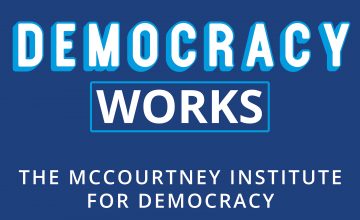Podcast: Play in new window | Download | Embed
Subscribe: Apple Podcasts | Spotify | Email | TuneIn | RSS | More

Pennsylvania received a new congressional map earlier this year, closing the books on what was widely considered one of the most egregious examples of partisan gerrymandering after 2010 census. Chris Satullo sees that decision as winning the battle against gerrymandering, but not the war.
Satullo, a civic engagement consultant for the Committee of Seventy, is involved with several initiatives to sustain the changes that were enacted this year and ensure that a fair map is drawn after the 2020 census.
The Committee of Seventy works closely with two organizations, Fair Districts PA and Draw the Lines PA. Fair Districts is a nonpartisan grassroots advocacy group working to ensure that the map doesn’t revet back to a gerrymandered state in 2021, while Draw the Lines aims to “fix the bug in the operating system of democracy” by empowering students and other groups to draw new maps.
We talked with Chris about how Pennsylvania’s map became so gerrymandered, what drove the desire to change it, and how people across the Keystone State can get involved with the effort to create a better map. In many ways, this effort embodies the essence of Democracy Works — people coming together build something that’s greater than the sum of its parts.
For more from Chris, check out his podcast, 20 by Seventy.
Interview Highlights
[5:50] What are Committee of 70, Fair Districts Pennsylvania, and Draw the Lines Pennsylvania, and how do those groups work together?
The Committee of 70 is a non-profit that is Pennsylvania’s oldest “good government group” founded more than 100 years ago in Philly. Fair Districts PA is a grassroots organization that was formed about a year and a half, two years ago, to work specifically on the redistricting, anti-gerrymandering front. Draw the Lines PA is a new initiative of us here at Committee of 70 which looks to connect with and support and sustain the work of Fair Districts PA.
[8:04] Why did it take so long for this effort to come to fruition, to get the map changed?
What changed dramatically in the last twenty years is the advent of computer technology and big data. Mapping software and big data about individual voters buying habits, not just election and political habits.
[9:44] If the 2016 election had gone a different way, would we be sitting here talking about this right now?
I’d like to assure you that Committee of 70, and I personally would’ve been talking about this issue because, it’s been a concern of mine as a journalist covering these legislatures for a long time.
[12:34] So what are you hoping people will do [with the map tools]? Why should people want to take part in this work?
What we want to show people is that, if you have the right tools in your hand, it is not difficult, in fact it is relatively easy, to draw a common sense map of Pennsylvania.
[15:06] How does the product of all this work make its way to the people who are responsible for what the states new map will look like?
A big focus of Draw the Lines will be getting this opportunity and this software and these tools into classrooms across Pennsylvania, both secondary school and colleges, professional schools, law schools and the like.
[19:40] Do you think we’re heading for a crazy decade ahead of maps changing all the time and all these challenges, and people not knowing what’s what or where their districts are or where things stand?
In the short term, yes, a lot of confusion. In the long term, I think what we’re seeing is the first glimmers of voters beginning to realize how significant this issue is in how disappointed and frustrated they are with what they get out of their State governments and out of Washington D.C.
[21:00] If people only have to time to do one thing, what should that be?
Right now they should contact their representatives in the State Legislature, both Senate and House, and tell them they want them to vote for the Constitutional Amendment.
